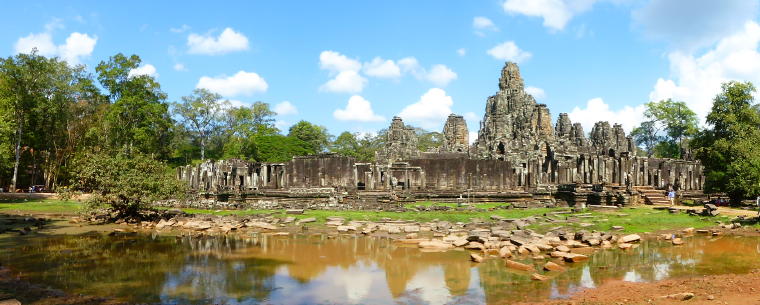|
December 9, 2015
We flew from Phnom Penh to Siem Reap, Cambodia, arriving just
before lunch. We were met by a new local guide, Rath. Siem Reap
is much smaller than Phnom Penh with only 170,000 people. Most drive
motor bikes. It was home to the ancient Kymer Empire from the 9th
to the 15th century.
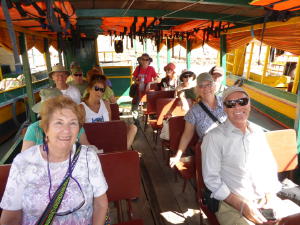 After
lunch we took a cruise on Tonle Sap, also known as the "Great
Lake". The lake is the largest in SE Asia - 60 miles wide by
150 miles long. It is a UNESCO World Heritage Site. There are more
than 400 species of fish in the lake. On the way to the lake we
got a glimpse into the lives of most of the Cambodian people - farmers.
We passed field after field of rice and cattle. We got on the boat
in the canal that leads to the lake and watched men wade into the
canal to drop nets to catch fish. After
lunch we took a cruise on Tonle Sap, also known as the "Great
Lake". The lake is the largest in SE Asia - 60 miles wide by
150 miles long. It is a UNESCO World Heritage Site. There are more
than 400 species of fish in the lake. On the way to the lake we
got a glimpse into the lives of most of the Cambodian people - farmers.
We passed field after field of rice and cattle. We got on the boat
in the canal that leads to the lake and watched men wade into the
canal to drop nets to catch fish.  Once
on the lake, we cruised past a floating village. There are 172 floating
communities on the lake, each with about 1000 residents. Their houses
are built on rafts made of either bamboo, styrofoam or oil drums.
Every 3-4 months the whole village moves to another part of the
lake as the amount of fish in that area is depleted. Once
on the lake, we cruised past a floating village. There are 172 floating
communities on the lake, each with about 1000 residents. Their houses
are built on rafts made of either bamboo, styrofoam or oil drums.
Every 3-4 months the whole village moves to another part of the
lake as the amount of fish in that area is depleted.
 After
the boat ride, we stopped in an agricultural village and took a
ride on a water buffalo cart. Water buffalo carts are used in the
villages to carry rice to be planted or to carry harvested rice
and other goods back to the village. This was Barbara's least favorite
of all the local means of transportation we got to experience. The
ride down a rutted dirt path was very bumpy and uncomfortable. But
worse than that, the cart behind her kept getting so close that
she expected the water buffalo to start licking her legs which were
hanging off the back of the cart. After
the boat ride, we stopped in an agricultural village and took a
ride on a water buffalo cart. Water buffalo carts are used in the
villages to carry rice to be planted or to carry harvested rice
and other goods back to the village. This was Barbara's least favorite
of all the local means of transportation we got to experience. The
ride down a rutted dirt path was very bumpy and uncomfortable. But
worse than that, the cart behind her kept getting so close that
she expected the water buffalo to start licking her legs which were
hanging off the back of the cart.
December 10, 2015
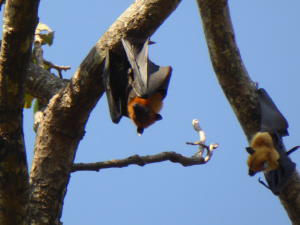 We
started the morning with a visit to the Royal Independence Gardens.
Large fruit bats were hanging from the trees and making alot of
noise.These bats have wing spans of 2 feet and look like birds when
they fly. The park is a popular spot for local bridal parties to
have their pictures taken. People also come here to buy tiny birds
which they release as an offering to Buddha. We
started the morning with a visit to the Royal Independence Gardens.
Large fruit bats were hanging from the trees and making alot of
noise.These bats have wing spans of 2 feet and look like birds when
they fly. The park is a popular spot for local bridal parties to
have their pictures taken. People also come here to buy tiny birds
which they release as an offering to Buddha. We were met by a woman selling lotus flowers. We were each given
a flower bud and she showed us how to fold the petals back to make
a pretty flower. People buy these and go to the nearby temple to
leave as an offering to Buddha and to make a wish for a good day.
We made our flowers and then followed the ritual. Our flowers weren't
near as perfect as this lady's!
We were met by a woman selling lotus flowers. We were each given
a flower bud and she showed us how to fold the petals back to make
a pretty flower. People buy these and go to the nearby temple to
leave as an offering to Buddha and to make a wish for a good day.
We made our flowers and then followed the ritual. Our flowers weren't
near as perfect as this lady's!
 Our
next stop was the Angkor National Museum. It contains an impressive
collection of ancient sculptures and artifacts. This is a beautiful
museum with 7 different galleries which tell the history of the
Khmer empire and the Angkor temples built by the great Khmer kings.
We spent over 2 hours in the museum and it was a great introduction
to what we would be seeing later. No photos were allowed inside
the museum. Our
next stop was the Angkor National Museum. It contains an impressive
collection of ancient sculptures and artifacts. This is a beautiful
museum with 7 different galleries which tell the history of the
Khmer empire and the Angkor temples built by the great Khmer kings.
We spent over 2 hours in the museum and it was a great introduction
to what we would be seeing later. No photos were allowed inside
the museum.
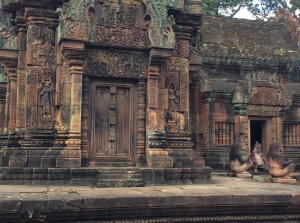 In
the afternoon we took the optional tour to visit Banteay Srei, one
of the oldest and most beautifully preserved temple sites in Cambodia.
Built in 967 AD, Banteay Srei means "Citadel of Women"
and is recognized as a tribute to female beauty. The buildings are
made of red sandstone with intricate carvings chiseled into the
stone. It is amazing how well they have lasted for almost 1000 years. In
the afternoon we took the optional tour to visit Banteay Srei, one
of the oldest and most beautifully preserved temple sites in Cambodia.
Built in 967 AD, Banteay Srei means "Citadel of Women"
and is recognized as a tribute to female beauty. The buildings are
made of red sandstone with intricate carvings chiseled into the
stone. It is amazing how well they have lasted for almost 1000 years.
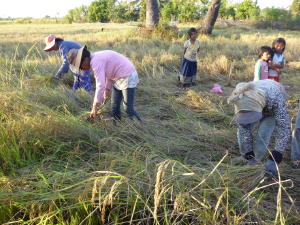 On
the way back from Banteay Srei, we passed some local farmers harvesting
rice near the side of the road. So our guide stopped and asked them
if we could "help". What back breaking work! They use
a scythe to cut the clumps of rice stalks and pull them from the
ground. Fred said it was really hard to do and he couldn't imagine
clearing a whole field, especially in this heat. On
the way back from Banteay Srei, we passed some local farmers harvesting
rice near the side of the road. So our guide stopped and asked them
if we could "help". What back breaking work! They use
a scythe to cut the clumps of rice stalks and pull them from the
ground. Fred said it was really hard to do and he couldn't imagine
clearing a whole field, especially in this heat.
December 11, 2015
Today we explored some of the major temples of the ancient city
of Angkor. It sprawls across an area of roughly 96 square miles
and is a UNESCO World Heritage Site. The Khmer Empire aristocrats
built the temples and monuments here between 800-1300 AD, motivated
by their Hindu and Buddhist beliefs.
 Our
first stop was to probably the most famous of the temples, Angkor
Wat. This is a large pyramid temple built between 1113 and 1150
AD. It is surrounded by a great moat 570 feet wide. Angkor Wat is
the largest religious monument in the world. The towers of the temple
represent Mount Meru, the center of all physical and spiritual universes
and the home to many gods in Hindu mythology. It was built as a
palace for the gods and is dedicated to the Hindu god Vishnu. Our
first stop was to probably the most famous of the temples, Angkor
Wat. This is a large pyramid temple built between 1113 and 1150
AD. It is surrounded by a great moat 570 feet wide. Angkor Wat is
the largest religious monument in the world. The towers of the temple
represent Mount Meru, the center of all physical and spiritual universes
and the home to many gods in Hindu mythology. It was built as a
palace for the gods and is dedicated to the Hindu god Vishnu.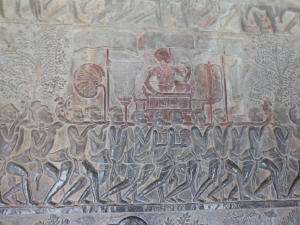 Surrounding the towers are four long galleries with bas relief carvings
depicting Hindu epics in great detail as well as the life of the
king who built the temple. The carvings are the longest bas relief
in the world and are in amazing condition. We spent over two hours
at Angkor Wat, first looking at the bas reliefs on the first level,
then wandering around the second level, and finally climbing up
steep steps to the third level for a nice view of the complex and
an up close look at the towers. If only it had been cooler, we would
have enjoyed it more. But the $1 fan we bought really helped.
Surrounding the towers are four long galleries with bas relief carvings
depicting Hindu epics in great detail as well as the life of the
king who built the temple. The carvings are the longest bas relief
in the world and are in amazing condition. We spent over two hours
at Angkor Wat, first looking at the bas reliefs on the first level,
then wandering around the second level, and finally climbing up
steep steps to the third level for a nice view of the complex and
an up close look at the towers. If only it had been cooler, we would
have enjoyed it more. But the $1 fan we bought really helped.
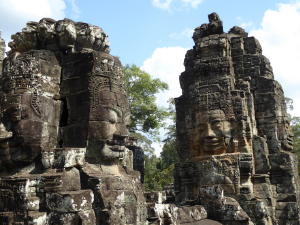 Our
next stop was to Angkor Thom which was the capital city of Khmer
rulers. The fortified city is spread over an area of almost 4 square
miles. It contains the Bayon temple which was one of our favorite
places. Our
next stop was to Angkor Thom which was the capital city of Khmer
rulers. The fortified city is spread over an area of almost 4 square
miles. It contains the Bayon temple which was one of our favorite
places.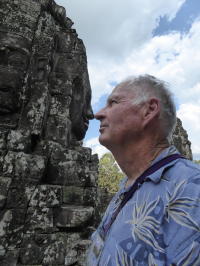 It contains 37 towers (originally there were 54), each with 4 faces
carved on the sides of the towers. These faces are said to depict
a Hindu god, a Buddhist god, or the king himself. The bas reliefs
along the gallery walls depict the life of the people, making noodles,
plowing fields, etc. Our guide had fun taking picures of us rubbing
noses with the gods!
It contains 37 towers (originally there were 54), each with 4 faces
carved on the sides of the towers. These faces are said to depict
a Hindu god, a Buddhist god, or the king himself. The bas reliefs
along the gallery walls depict the life of the people, making noodles,
plowing fields, etc. Our guide had fun taking picures of us rubbing
noses with the gods!
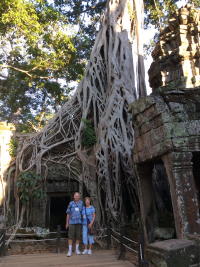 After
lunch and a brief rest and cool down at the hotel, we visited Ta
Prohm. Unlike Angkor Wat, Ta Prohm has been left the way it was
found, covered by a dense jungle of trees and roots. Strangler figs,
and strung (a kapok-like tree) are entwined among the ruins, making
for some interesting photos. This is to give people an idea of what
it might have looked like when it was discovered by the French in
the mid 1800's. The roots and trees are such an integral part of
the sturcture that they are actually holding it up in many places. After
lunch and a brief rest and cool down at the hotel, we visited Ta
Prohm. Unlike Angkor Wat, Ta Prohm has been left the way it was
found, covered by a dense jungle of trees and roots. Strangler figs,
and strung (a kapok-like tree) are entwined among the ruins, making
for some interesting photos. This is to give people an idea of what
it might have looked like when it was discovered by the French in
the mid 1800's. The roots and trees are such an integral part of
the sturcture that they are actually holding it up in many places.
Dinner was on our own this evening so 6 of us took a tuk tuk into
downtown Siem Reap called Pub Street. This was a happening place
with all kinds of restaurants, bars, massage parlors and a night
market. We bought a couple of T-shirst for $4 and had dinner at
the Red Piano. Fred had a hamburger and fries while Barb had Quiche
Lorraine. It was a nice change from our Cambodian meals. These have
been very good but we were ready for something different!
To view more photos from our trip to Siem Reap, please go to Siem
Reap Photo Gallery. To read about the next place we visited,
go to Saigon Newsletter.
Home
Locations Visited Photos Map
Contact Us
|
